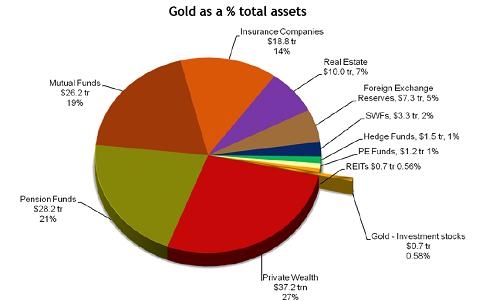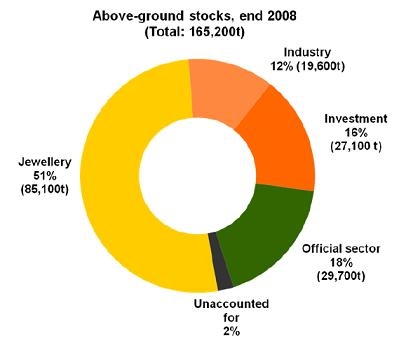Gold investment has more room for growth
Gold is attracting new buyers fast, writes Adrian Ash. But compared to the 1930s depression or the inflationary panic of the late 1970s, the world’s wealth is still very under-invested.
"FEAR, Mr. Bond, takes gold out of circulation and hoards it against the evil day," as 007 learns from a Bank of England officer in Ian Fleming's
(1959).
MoneyWeek
Subscribe to MoneyWeek today and get your first six magazine issues absolutely FREE

Sign up to Money Morning
Don't miss the latest investment and personal finances news, market analysis, plus money-saving tips with our free twice-daily newsletter
Don't miss the latest investment and personal finances news, market analysis, plus money-saving tips with our free twice-daily newsletter
So "in a period of history when every tomorrow may be the evil day, it is fair to say that a fat proportion of the gold dug out of one corner of the earth is at once buried again in another corner."
Evil-day gold buying really motored since the credit collapse began in August 2007. Soaking up investment dollars worldwide, in fact, new allocations to the metal whether trust fund or owned outright swelled by 38% during the first quarter of 2009 compared with total demand between Jan. and March 2008, according to marketing-group the World Gold Council (WGC).
Within that figure, what the GFMS consultancy (who supply the WGC with its data) calls "identifiable investment" leapt 248% compared to Q1 08. And gold ETFs made the headlines once more, sucking in "another quarterly record" as new inflows required 465 tonnes of metal to back them, thus dwarfing the previous record of 149 tonnes set in the third quarter of last year.
That doesn't mean the world's investors are now all in, however. According to the World Gold Council's Marcus Grubb last month (using we-don't-know-which data), current gold investment allocation stands at less than 0.6% of total global wealth.

It makes a nice pie chart, and it offers a useful snapshot of different asset classes vs. each other. But we also think the idea's worth refining. Because this estimate both over-states liquid assets in toto and under-estimates the stock of gold available to investment flows whether retail or wholesale.
First, note the scope for double-counting between pension, mutual and insurance funds. I'm not saying the WGC's data trips up on that error, but you can see how likely it seems given the end-allocation categories applied. For instance, "hedge funds" are stripped out separately (as are REITs and private-equity), even though institutional allocations via funds-of-funds will be counted elsewhere under the broader "funds" title.
Similarly, but more pertinent, the outstanding quantity of "gold investment stocks" underplays the true volume of metal held as a store of wealth. Simply counting the "investment" volume excludes fully 84% of the above-ground supply, as another chart from the WGC's presentation shows.

Why not also include "official sector" gold hoards? Sovereign wealth funds and FX reserves were included on the other side of the ledger, after all.
More crucially still, why not include jewelry? Trying to split out the volume of trinkets held for aesthetics alone might feel easy enough to a Western analyst just back from window-shopping at Mappin & Webb. But across south-east Asia, and most particularly in India typically the world's No.1 destination for physical gold each year large, chunky necklaces and bracelets make for "investment jewelry", acting as a store of wealth in the absence of any formal banking network.
Still, the point is well made, we believe. Gold remains but a slither of investable wealth albeit a fast-growing slither as the value of other assets has dropped.
"Gold [has] been deprecated and reduced as a financial asset," as Jeffrey Christian of the CPM consultancy put it earlier this year. "In 1968 gold may have represented 4.5% to 5.0% of the world's wealthBy the 1990s it was down to 0.2% of the world's wealth. Not that gold was falling in value so much as the other wealth stocks, bonds, paper assets, government bonds, corporate bonds, bank deposits were exploding once the tie to gold was severed.
"In 2006 gold represented 0.2% of world wealth. At the end of 2007, it was about 0.4%. Depending on what you think about wealth destruction in 2008, it may have been 0.6%."
That figure just about matches the WGC's estimate of 0.7% (perhaps they used the same inputs and excluded the same volumes of central-bank and jewelry gold?). It also contrasts with our own Estimate of Gold as a Proportion of Investable Wealth at nearer 2.7% by the close of 2008.
Either way, gold is fast-attracting attention both from nay-sayers, retail investors and new die-hard bulls amongst the professional institutions. Regulatory filings show legendary hedge-fund manager John Paulson took his position in the SPDR Gold ETF to 30% of his portfolio during the first quarter of 2009. Paulson & Co. now owns 8.7% of that paper as well as significant chunks of the Gold Miners ETF (NYSE:GDX), Kinross Gold (NYSE:KGC), Gold Fields (NYSE:GFI) and AngloGold Ashanti (NYSE:AU) if not any actual bullion itself.
Does that in itself make gold a buy? Of course not. But compared to the evil days of 1930s depression or the fearful inflationary panic of the late 1970s the world's wealth remains very under-invested in metal right now.
This article was written by Adrian Ash, editor of Gold News and head of research at BullionVault
Get the latest financial news, insights and expert analysis from our award-winning MoneyWeek team, to help you understand what really matters when it comes to your finances.
Adrian has written all things gold related from if it’s worth buying, what the real price of gold should be and what’s the point of gold for MoneyWeek. He has also written for other leading money titles on his gold expertise including Business Insider, Forbes, City A.M, Yahoo Finance and What Investment Magazine. Now Adrian is head of the research desk at BullionVault, a physical market for gold and silver for private investors online.
-
 Top stock ideas for 2026 that offer solidity and growth
Top stock ideas for 2026 that offer solidity and growthLast year’s stock ideas from MoneyWeek’s columnist and trader, Michael Taylor, produced another strong performance. This year’s stocks look promising too
-
 My market predictions for 2026
My market predictions for 2026Opinion My 2026 predictions, from a supermarket merger to Dubai introducing an income tax and Britain’s journey back to the 1970s
